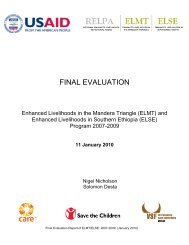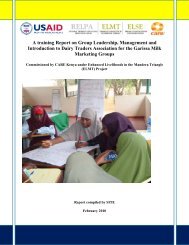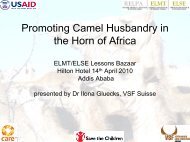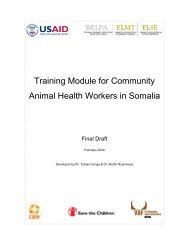Impact Assessment of the Community Animal Health System in ...
Impact Assessment of the Community Animal Health System in ...
Impact Assessment of the Community Animal Health System in ...
You also want an ePaper? Increase the reach of your titles
YUMPU automatically turns print PDFs into web optimized ePapers that Google loves.
assessment agree with earlier studies which show that CAHWs can diagnose and treat diseases<br />
correctly. The assessment showed that CAHW treatments are not perfect but this f<strong>in</strong>d<strong>in</strong>g is not<br />
surpris<strong>in</strong>g ‐ no cl<strong>in</strong>ical service <strong>in</strong> ei<strong>the</strong>r animal health or human health, anywhere <strong>in</strong> <strong>the</strong> world, will<br />
produce complete cure rates – this is <strong>the</strong> nature <strong>of</strong> cl<strong>in</strong>ical medic<strong>in</strong>e. While <strong>the</strong> veter<strong>in</strong>ary<br />
establishment <strong>in</strong> Kenya cont<strong>in</strong>ues to block CAH systems at policy and legislative levels, it would be<br />
useful to assess <strong>the</strong> cl<strong>in</strong>ical competence <strong>of</strong> veter<strong>in</strong>arians and compare this is to para‐veter<strong>in</strong>ary<br />
pr<strong>of</strong>essionals such as CAHWs. Such a study would no doubt reveal that cl<strong>in</strong>ical competence not only<br />
relates to level <strong>of</strong> tra<strong>in</strong><strong>in</strong>g, but also, to hands‐on cl<strong>in</strong>ical experience. Until <strong>the</strong> veter<strong>in</strong>ary pr<strong>of</strong>ession <strong>in</strong><br />
Kenya opens itself up to such scrut<strong>in</strong>y, it rema<strong>in</strong>s debatable where <strong>the</strong> technical competence really<br />
resides. There is no system <strong>in</strong> <strong>the</strong> veter<strong>in</strong>ary board <strong>in</strong> Kenya for reassessment <strong>of</strong> veter<strong>in</strong>arian’s cl<strong>in</strong>ical<br />
knowledge over time, no system for cont<strong>in</strong>u<strong>in</strong>g pr<strong>of</strong>essional development and few, if any, examples<br />
<strong>of</strong> veter<strong>in</strong>arians be<strong>in</strong>g discipl<strong>in</strong>ed or removed from <strong>the</strong> veter<strong>in</strong>ary register.<br />
Look<strong>in</strong>g specifically at <strong>the</strong> CFR results, <strong>in</strong> general <strong>the</strong> curative treatments provided by CAHWs<br />
resulted <strong>in</strong> significantly fewer livestock deaths compared to treatments adm<strong>in</strong>istered by herd owners<br />
(Table 2). Fur<strong>the</strong>rmore, <strong>the</strong> reductions <strong>in</strong> CFR aris<strong>in</strong>g from CAHW treatments were <strong>of</strong>ten substantial<br />
(Tables 3 to 5). For example, CAHW had dramatic impact on mortality due to trypanosomosis <strong>in</strong><br />
cattle (Table 5). It seems reasonable to assume that this level <strong>of</strong> CAHW performance did not happen<br />
by chance, but was due to a comb<strong>in</strong>ation <strong>of</strong> knowledge and skills acquired through tra<strong>in</strong><strong>in</strong>g, and <strong>the</strong><br />
correct use <strong>of</strong> appropriate veter<strong>in</strong>ary drugs. For camel diseases, <strong>the</strong> assessment f<strong>in</strong>d<strong>in</strong>gs agreed with<br />
earlier studies <strong>in</strong> Kenya. For example, a comparison <strong>of</strong> camel herds with and without veter<strong>in</strong>ary care<br />
<strong>in</strong> nor<strong>the</strong>rn Kenya showed that mortality due to disease <strong>in</strong> calves was 44.8% <strong>in</strong> untreated herds but<br />
only 5.4% <strong>in</strong> treated herds. In adult camels, mortality due to disease was 26.7% <strong>in</strong> untreated herds<br />
and 4.3% <strong>in</strong> treated herds 17 .<br />
Although <strong>the</strong> assessment did not aim to directly measure livelihoods impact <strong>of</strong> CAHW activities,<br />
disease such as trypanosomosis, helm<strong>in</strong>thosis, CBPP, CCPP and mange have been reported <strong>in</strong> Somali<br />
pastoral areas s<strong>in</strong>ce <strong>the</strong> 1940s and are known to have important impacts <strong>in</strong> terms <strong>of</strong> production (e.g.<br />
milk, fertility) and mortality. For poorer households who rely more on sheep and goats, CCPP, PPR,<br />
helm<strong>in</strong>thosis and NSD are important diseases with CCPP, PPR and NSD caus<strong>in</strong>g high mortality and<br />
<strong>the</strong>refore, loss <strong>of</strong> key assets; NSD causes higher mortality <strong>in</strong> sheep and goats <strong>in</strong> Africa than any o<strong>the</strong>r<br />
<strong>in</strong>fectious disease.<br />
In <strong>the</strong> case <strong>of</strong> CBPP <strong>the</strong>re are mixed op<strong>in</strong>ions among veter<strong>in</strong>arians concern<strong>in</strong>g <strong>the</strong> use <strong>of</strong> antibiotics to<br />
treat this disease, <strong>of</strong>ten based on concerns that <strong>the</strong> use <strong>of</strong> antibiotics encourages carrier status and<br />
makes eradication more difficult <strong>in</strong> <strong>the</strong> long term. More recent studies contest this view. For example:<br />
<strong>the</strong>re appears to no scientific evidence that <strong>the</strong> treatment <strong>of</strong> CBPP cases with antibiotics results <strong>in</strong><br />
carrier status 18 and antibiotics have been shown to be beneficial <strong>in</strong> limit<strong>in</strong>g <strong>the</strong> impact <strong>of</strong> <strong>the</strong> disease 19 .<br />
Oxytetracycl<strong>in</strong>e has been used to treat CCPP for many years. In central Somalia <strong>in</strong> <strong>the</strong> late 1980s it<br />
was considered to be an effective treatment 20 and more recent research has <strong>in</strong>dicated <strong>the</strong> value <strong>of</strong><br />
17 Simpk<strong>in</strong>, P.S. (1985). The effects <strong>of</strong> disease as a constra<strong>in</strong>t to camel productivity <strong>in</strong> nor<strong>the</strong>rn Kenya. MPhil. Thesis, University<br />
<strong>of</strong> London.<br />
18 Mar<strong>in</strong>er, J.C., McDermott, J., Heesterbeek, J.A.P., Thomson, G., Roeder, P.L. and Mart<strong>in</strong>, S.W. (2006). A heterogeneous<br />
population model for contagious bov<strong>in</strong>e pleuropneumonia transmission and control <strong>in</strong> pastoral communities <strong>of</strong> East Africa.<br />
Preventive Veter<strong>in</strong>ary Medic<strong>in</strong>e 73/1, 75‐91.<br />
19 Otto J.B. Huebschle, Roger D. Ayl<strong>in</strong>g, Kev<strong>in</strong> God<strong>in</strong>ho, Obed Lukhele, Georg<strong>in</strong>a Tjipura‐Zaire, Tim G. Rowan, Rob<strong>in</strong> A.J.<br />
Nicholas (2006). Dan<strong>of</strong>loxac<strong>in</strong> (Advoc<strong>in</strong>) reduces <strong>the</strong> spread <strong>of</strong> contagious bov<strong>in</strong>e pleuropneumonia to healthy <strong>in</strong>‐contact<br />
cattle. Research <strong>in</strong> Veter<strong>in</strong>ary Science 81, 304–309.<br />
20 In 46/47 reports were <strong>in</strong>formation on <strong>the</strong> efficacy <strong>of</strong> oxytetracycl<strong>in</strong>e was available, <strong>the</strong> treatment was reported as efficacious. The<br />
reference is:<br />
Baumann, M.P.O. (1990). The Nomadic <strong>Animal</strong> <strong>Health</strong> <strong>System</strong> (NAHA‐<strong>System</strong>) <strong>in</strong> Pastoral Areas <strong>of</strong> Central Somalia and Its<br />
Usefulness <strong>in</strong> Epidemiological Surveillance. MPVM <strong>the</strong>sis, University <strong>of</strong> California, Davis.<br />
15












